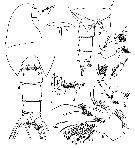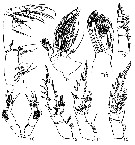|
|
 |
|
Calanoida ( Order ) |
|
|
|
Clausocalanoidea ( Superfamily ) |
|
|
|
Phaennidae ( Family ) |
|
|
|
Xanthocalanus ( Genus ) |
|
|
| |
Xanthocalanus quasiprofundus Vyshkvartzeva, 2002 (F) | |
| | | | | | | Ref.: | | | Vyshkvartzeva, 2002 (p.91, figs.F) |  Issued from : N.V. Vyshkvartzeva in Zoosyst. Rossica , St. Petersburg, 2002, 11. [p.92, Figs.1-8]. Female (from 85°54'6''N, 47°02'4''W): 1, forehead (lateral); 2, rostrum (ventral); 3, 5th thoracic segment with P5 and urosome (right side); 4, sema (ventral view); 5, A2; 6, Md (masticatory edge of gnathobase); 7, Md palp; 8, Mx1. Nota: - Cephalosome and 1st pedigerous segment fused, 4th and 5th thoracic segments fused, but thin articulation sutures visible. - Rostrum as a short plate with 2 long delicate filaments posteriad. - Urosome as long as 1/4 of prosome.
- Urosome in proportional length 39 : 21 : 18 : 9 : 10 = 100.
Urosomal segments 1-3 striated along posterior margin.
- Caudal rami as long as wide; inner margin with long setules; dorsal (S7) and ventral (S2) setae absent.
- Genital segment 1.3 times as long as wide, laterally without genital swelling, with a tuft of setules near genital opening (fig.3). Transverse genital opening and comparatively small operculum located just before midlength of genital segment. Spermatheca elongate; lateralm triangular skeletal plates well developed. Paired copulatory pores lie behind genital opening (fig.4).
- A1 24-segmented, reaching posterior margin of urosomal segment 1.
- A2 endopod about 0.75 times as long as exopod 6-segmented.exopodal segments 1-6 with 0, 1, 1, 1, 1, 0+3 setae, respectively.
- Md: gnathobase with 10 teeth and 1 slender dorsal spinulose seta; there are spinules of various sizes along bases of central teeth; 3 ventral teeth much higher than the rest, with multicusped crowns; 2 central teeth unicusped; 2 other central and 3 dorsal teeth bicusped; one tip of dorsalmost tooth remarkably elongate. Basis with 3 long inner setae; endopod as long as exopod; endopodal segment 1 with 2, endopodal segment 2 with 9 setae.
-Mx1: inner lobe 1 with 9 marginal, 4 posterior (S11-S14) and 1 anterior (S6) setae, length of marginal setae remarkably increase distally; inner lobe 2 with 2 long and 1 short setae; inner lobe 3 with 2 long and 2 shorter setae; inner lobe 4 with 3 long, 2 shorter and 1 small setae; endopodal segment 1 fused with basis, with 3 setae; endopodal segment 2 fused with the 1st, with 2 setae; 3rd endopodal segment with 4 setae; exopod with 10 and outer lobe 1 with 9 setae.
|
 Issued from : N.V. Vyshkvartzeva in Zoosyst. Rossica , St. Petersburg, 2002, 11. [p.93, Figs.9-16]. Female: 9, Mx2; 10, Mx2 distal endopodal complex; 11, Mxp; 12, P1; 13, P2; 14, P3; 15, P4; 16, P5. Nota: - Mx2 compact; inner lobes 1-3 short, subequal; inner lobe 1 with 5 setae (4 long plumose and 1 shorter and thinner); inner lobe 2 with 2 long plumose and 1 shorter but more coarsely plumose setae; inner lobe 3 with 1 long, plumose seta, 1 short, coarsely plumose seta, and short, worm-like sensory seta; inner lobe 4 with 1 long plumose seta, 1 shorter and more coarsely plumose seta and 1 more strongly sclerotized long seta tapering distally, with long, strong, dense spinules; inner lobe 5 with 2 strong claw-like setae( 1 plumose and 1 with very strong spinules) and 2 worm-like setae, of which one is tapering and seems only partly transformed; endopod indistinctly 4-segmented; endopodal segments 1-3 each bearing 2 brush-like sensory setae; one brush-like seta on endopodal segment 3 much shorter and thicker, with apical brush formed of numerous long setules; endopodal segment 4 with 1 brush-like and 1 worm-like sensory seta (distal part of worm-like seta seems to be missing). - Mxp syncoxa with 1 plumose seta and 2 worm-like setae proximally, the latter with setular rows along their length; with 1 seta and 1 brush-like sensory seta medially; with 3 plumose setae subterminally and patch of minute spinules terminally; basis slightly longer than syncoxa, bearing patch of minute spinules proximally and 3 plumose setae medially; endopod as long as 2/3 of basis, with 2+4, 4, 4, 3, 3+1 outer and 4 terminal setae, respectively; one of the setae on each endopodal segments 1-3 stout, spinulose, with scythe-shaped terminal part. - P5 uniramous, 3-segmented; proximal segment on inner margin with row of small spinules proximally and short thickened spinules distally; 2nd segment twice as long as wide and slightly longer than distal segment, with patch of long lancet-like spinules along distal half of outer margin; distal segment 2.2 times as long as wide, its posterior surface with long spinules plus group of shorter spinules distally, terminally there are 4 serrate spines (2 apical, inner slightly longer than outer, one, the longest, inner, and one outer spine as long as 2/3 of inner and situated opposite to inner spine.
| | | | | NZ: | 1 | | |
|
Distribution map of Xanthocalanus quasiprofundus by geographical zones
|
| | | | Loc: | | | Arctic (Nansen Basin) | | | | N: | 1 | | | | Lg.: | | | (878) F: 7,6; {F: 7,60} | | | | Rem.: | ? Bathypelagic ;
For Vyshkvartzeva (2002, p.94) this species is very close to X. profundus Sars, but differs in the larger size (7.6 mm vs. 6.2 mm), presence of 10 teeth on masticatory edge of Md gnathobase (vs. 8 teeth according to Sars' fig.6) and of spinules near bases of central teeth, one worm-like sensory seta and 2 plumose setae on inner lobe 3 of Mx2 (vs. 3 plumose setae, according to Sars' fig.8), one brush-like seta of Mx2 endopod much thicker and shorter compared with 6 others, apical filaments of brush-like sensory setae longer (vs. all brush-like setae similar and delicate, according to Sars' description and fig.8), syncoxa of Mxp with 8 setae (as in Sars' fif.9), but in the new species there are 3 sensory setae, of which 2 are worm-like and 1 short brush-like (vs. only plumose setae, according to Sars' fig.9), exopodal segment 1 of P4 with transverse row of spinules.
X. quasiprofundus could belong to the X. minor group (see Campaner, 1978), where one brush-like seta of endopod of Mx2 is enlarged, shorter and wider than 6 other brush-like setae. | | | Last update : 12/03/2015 | |
|
|
 Any use of this site for a publication will be mentioned with the following reference : Any use of this site for a publication will be mentioned with the following reference :
Razouls C., Desreumaux N., Kouwenberg J. and de Bovée F., 2005-2025. - Biodiversity of Marine Planktonic Copepods (morphology, geographical distribution and biological data). Sorbonne University, CNRS. Available at http://copepodes.obs-banyuls.fr/en [Accessed April 04, 2025] © copyright 2005-2025 Sorbonne University, CNRS
|
|
 |
 |





